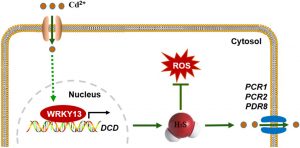Hydrogen Sulfide and Cadmium Stress
Cadmium (Cd) negatively impacts plant yield by causing growth inhibition, chlorosis, or even the death of entire plants. Cd interferes with  the uptake and translocation of other ions, damages protein and DNA/RNA functions, and increases the accumulation of reactive oxygen species (ROS). An increasing number of reports indicate that hydrogen sulfide (H2S), a plant gasotransmitter, functions in plant responses to Cd stress. Exogenous application of NaHS, which releases H2S, for example, alleviates the toxic effects of Cd in plants. Two enzymes, L-CYSTEINE DESULFHYDRASE (LCD) and D-CYSTEINE DESULFHYDRASE (DCD), degrade L-Cys and D-Cys, respectively, into H2S, pyruvate, and NH3. Both of these enzymes could potentially be involved in mitigating Cd toxicity. Indeed, lcd mutants are more sensitive to Cd stress than are wild type, and plants overexpressing LCD are insensitive to Cd stress. Whether DCD plays a role in plant Cd tolerance is unknown. Zhang et al. (10.1104/pp.19.01504) now report that DCD-mediated H2S production enhances Cd tolerance in Arabidopsis. When subjected to Cd stress, a dcd mutant accumulated more Cd and ROS and showed increased Cd sensitivity, whereas transgenic lines overexpressing DCD had decreased Cd and ROS levels and were more tolerant to Cd stress compared with wild-type plants. Furthermore, the expression of DCD was stimulated by Cd stress, and this up-regulation was mediated by a Cd-induced transcription factor, WRKY13, which binds to the DCD promoter. The higher Cd sensitivity of the wrky13-3 mutant was rescued by the overexpression of DCD. These results suggest that Cd-induced WRKY13 activates DCD expression to increase the production of H2S, leading to higher Cd tolerance in plants.
the uptake and translocation of other ions, damages protein and DNA/RNA functions, and increases the accumulation of reactive oxygen species (ROS). An increasing number of reports indicate that hydrogen sulfide (H2S), a plant gasotransmitter, functions in plant responses to Cd stress. Exogenous application of NaHS, which releases H2S, for example, alleviates the toxic effects of Cd in plants. Two enzymes, L-CYSTEINE DESULFHYDRASE (LCD) and D-CYSTEINE DESULFHYDRASE (DCD), degrade L-Cys and D-Cys, respectively, into H2S, pyruvate, and NH3. Both of these enzymes could potentially be involved in mitigating Cd toxicity. Indeed, lcd mutants are more sensitive to Cd stress than are wild type, and plants overexpressing LCD are insensitive to Cd stress. Whether DCD plays a role in plant Cd tolerance is unknown. Zhang et al. (10.1104/pp.19.01504) now report that DCD-mediated H2S production enhances Cd tolerance in Arabidopsis. When subjected to Cd stress, a dcd mutant accumulated more Cd and ROS and showed increased Cd sensitivity, whereas transgenic lines overexpressing DCD had decreased Cd and ROS levels and were more tolerant to Cd stress compared with wild-type plants. Furthermore, the expression of DCD was stimulated by Cd stress, and this up-regulation was mediated by a Cd-induced transcription factor, WRKY13, which binds to the DCD promoter. The higher Cd sensitivity of the wrky13-3 mutant was rescued by the overexpression of DCD. These results suggest that Cd-induced WRKY13 activates DCD expression to increase the production of H2S, leading to higher Cd tolerance in plants.



